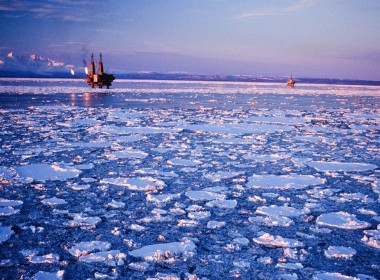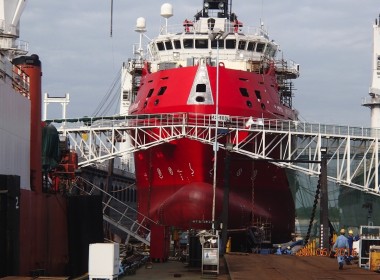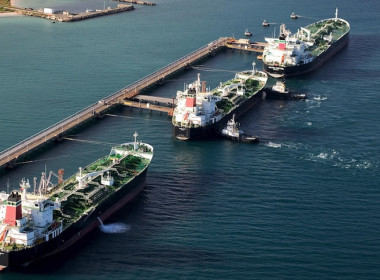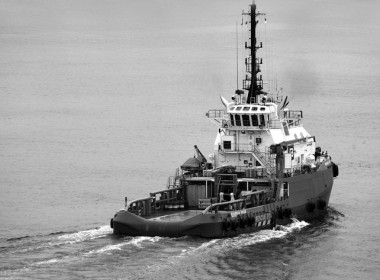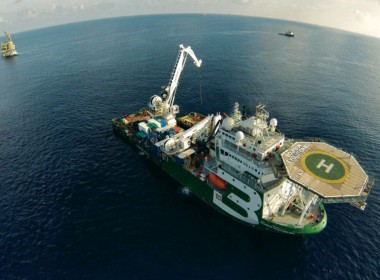COLUMN | It’s happening all over again: Oil price crash hits Tullow, Premier, Cairn hard – Part 2 [Offshore Accounts]

When we wrote our first piece on the circular nature of events in the offshore industry, less than three weeks ago (here), we never expected that we’d be revisiting the bad times all over again. But it is happening all over again.
On Monday March 9, for the second time in less than five years, the oil price crashed towards $30 per barrel, after a couple of glorious years of relative stability trading over $50 (nice ten year graph of the Brent price is available here).
Shot through the heart, and Riyadh’s to blame
The last time prices touched $30 was in January 2016, when the offshore industry recession was already well entrenched, as Brent prices had already dropped away from their $100+ plateau over the preceding eighteen months.
Then, the slump to $30 marked the kick in the teeth for an industry that was already down. Rigs and boats saw their contracts cancelled, and offshore drilling activity hit a five-year low. There was not a single FPSO contract awarded in 2016 anywhere in the world, according to brokers Kennedy Marr (and none in the second half of 2015 either).
However, OPEC and Russia reacted quickly to cobble together a production restriction agreement to remove oil supply from the market and support prices. The future for oil prices looked “lower for longer,” but a floor at $50 seemed to have been established.
Pump up the jam crude
Until, that is, the Covid-19 pandemic began, and customer demand in China slumped. This time round, though, Russia and Saudi Arabia disagreed regarding who should reduce capacity to support prices.
Instead of reaching an amicable agreement to restrain supply in alliance with the Russians and other Gulf OPEC countries, the Saudi Arabians announced that they would open the taps and increase their crude production by two million barrels a day, at a time when the world economy is reeling from the coronavirus outbreak.
Planes aren’t flying, ships aren’t sailing, and vehicles aren’t driving as much, as people quarantine and stay at home. When supply goes up, and demand goes down at the same time, then prices crash. This is basic economic theory, and it worked as per the textbook when markets opened on Monday.
Shale, born in the U.S.A.
A follow on is that weak prices impact high cost producers hardest. They will become uneconomical and will be compelled to suspend operations, reducing supply and eventually resting the market to balance.
The Saudis and the Russians have clearly identified which higher cost producers they want to exit the business: American shale oil companies. Shale oil drove US oil output from 5.7 million barrels per day in 2011 to a record 11.6 million barrels a day in 2018, more than Saudi Arabia or Russia produce themselves.
But at $30 per barrel, Rystad Energy has calculated (here) that only four US shale oil producers are profitable – and three of the four are names you may well recognise – Exxon Mobil, Occidental Petroleum, Chevron, and Crownquest Operating.
The hundred or so other shale oil producers cannot make money at $30 a barrel price level. Heavily indebted Occidental immediately announced it was slashing its dividend to conserve cash this week (here) after its share price fell over 50 per cent on Monday, March 9 following the Saudi Arabian announcement of the kingdom’s new production strategy.
Everybody hurts. Sometimes
Unfortunately, in any war, there will be collateral damage. In this case the collateral damage is borne by two innocent bystanders – the first being poorer countries dependent on oil exports, like Nigeria and Angola, Iran and Iraq, which have already suffered a torrid five years of falling exchange rates, shrinking state budgets, and political crises.
The second group is much closer to home: small and medium sized offshore exploration and production companies. Whilst the shale oil players like Occidental were hammered, the market turmoil smashed smaller offshore E&P players as well.
Premier Oil’s shares fell 57 per cent, whilst EnQuest and Tullow Oil dropped by about a third on the London Stock Exchange on that single day. Mediterranean player Energean, and North Sea-focused Hurricane were hit as well.
The day after, Cairn Energy announced a bumper operating profit of US$155 million for 2019 compared to a 2018 operating loss of US$129 million. Unfortunately, the damage was done. In January Cairn Energy stock had traded at over 200 pence. By close on Wednesday March 11, it was trading at less than 75 pence. By then the news that Cairn’s second Mexican well was also dry mattered little.
Kris Kross energy – jump!
As in 2016, there is a serious risk that $30 oil prices will destroy smaller oil and gas explorers and producers, as much as it will harm oilfield service players. Some, like troubled Singapore player Kris Energy look desperately vulnerable – Kris was already reporting larger losses for 2019 (reported here) and was trading under a debt moratorium.
Kris owes over US$500 million. Kris’s Cambodian offshore Apsara field development in the Gulf of Thailand is not viable at $30 a barrel, and is not yet producing, so the company’s cash flows are limited to a just few liftings from its share in Wassana Field in Thailand, and it urgently needs fresh cash to progress Apsara to first oil. That is unlikely to be forthcoming if oil continues to languish in the thirties.
I get weak (Premier)
The move away from the North Sea by the oil majors leaves North Sea production (and with it demand for offshore supply vessels), especially in the UK sector, dependent on smaller companies with weaker balance sheets and operating costs, which are higher than the integrated majors with their diversified balance sheets.
Last year ExxonMobil sold out of Norway. Shell and BP have been withdrawing from the North Sea gradually. For their smaller successors, it is happening all over again. Premier Oil and EnQuest spent most of 2016 in negotiations with their very unhappy lenders.
At that time, Premier had US$2.8 billion of debt and a bunch of capital-intensive projects that were not all viable at the lower 2016 oil price. Its Falkland Islands FPSO development was put on hold and still remains on hold today.
Now, Premier is trying to balance a US$2.9 billion refinancing of its debts with almost $900 million of acquisitions the company announced in January to acquire operating stakes in five producing fields and a 27.5 per cent non-operating stake in another from BP.
The timing of Premier’s new North Sea purchases is terrible. Premier’s lenders have signed off on the deals but the chances that its shareholders will fund the US$500 million equity rights call look low as it had not secured shareholder backing when oil plunged on Monday. Today Premier’s market cap is hovering around US$300 million.
The (bad) luck of the Irish (Tullow)
Tullow’s timing is equally unfortunate. In late 2019 it was hammered when it warned of a US$1.5 billion write-down because of lower long-term crude prices, and because of disappointing results in Guyana, where it found the wrong sort of oil in the wrong quantities. The company carries nearly US$3 billion of debt.
Tullow was the worst performing share on the FTSE 350 index in 2019. Tullow’s write down was based on a forecasted downgrade from $75 a barrel to $65 a barrel, not down to $35. Tullow’s CEO and exploration head quit in the wake of those shocks. The company then followed up in February that its expensive 35 per cent share in a wildcat well off Peru, had been a dry hole too (see here).
Cairn Energy, the road is long
The last crisis saw Cairn Energy withdraw from its ambitions to become a high cost Arctic exploration player off Greenland and focus on generating cash in the North Sea and spending it in Mexico and Senegal.
Cairn finished 2019 with strong cash position of close to US$200 million. What is there not to like? Unfortunately, Cairn faces a massive capital outgoing on the Woodside-operated Sangomar project in Senegal.
Cairn’s share of the development costs is $400 million, which will be spent drilling 23 wells in water depth of up to 1,100 metres and installing a Modec-designed FPSO with capacity of 100,000 bpd. Sangomar would be a great project at any other time, with life of the field total recoverable resources of around 500 million barrels gross and first oil expected in the first half of 2023.
A note tucked away (here) on page 12 of Cairn’s Results presentation shows that the Sangomar break even cost is $41 per barrel. Do the maths yourself and ask whether you would hurry along the project at a time when oil is priced at less than $35…
So, this downturn finds several of the smaller E&P players exposed. Expect projects to be delayed, costs to be cut, and boats and rigs to be offhired. Again. Cairn already announced a withdrawal from exploration from Nicaragua. Expect more cancellations. In a $30 oil environment, oil company offshore drilling programmes will resemble airline departures in this time of Covid-19.
The end of the world as we know it for Valaris DS-8
The bang you heard over the weekend wasn’t just the oil price hitting rock bottom. There’s only one thing worse than dropping the ball, and that is dropping the blow out preventor stack onto the seabed from a deepwater rig in transit between two drilling locations. This happened on the Valaris DS-8 on Saturday, March 7.
This was very unfortunate for Valaris, as this rig was on a golden legacy day rate to Total Angola of $634,000 as we highlighted last month (here). Guess what? If the rig breaks down or drops its BOP on the seabed, then Total can cancel the contract.
Valaris has warned that if this happens, then $150 million of its forecast 2020 EBIDTA cash flow would disappear. And its forecast of EBIDTA for the whole year was only $210 million to $240 million. So that one operational mistake could wipe out most of this year’s earnings and plunge the company into a debt crisis.
The full Valaris release to the stock market is here – Valaris stock fell over 80 per cent between close Friday and close on Wednesday. The market is pricing the company for distress.
I pity the poor sod whose mistake led to this operational and likely financial disaster. Is Total going to be so mean-hearted to use this problem as an opportunity to cancel the rig and save itself nine months of hire at $634,000 per day when they could be paying $200,000 at current market rates, a saving of over $110 million for them?
There is so much talk of “win-win” and “partnership” and “stakeholders” but what does this mean when an opportunity like this arises to terminate a rig contract fixed way above market rates?
What do you think?


